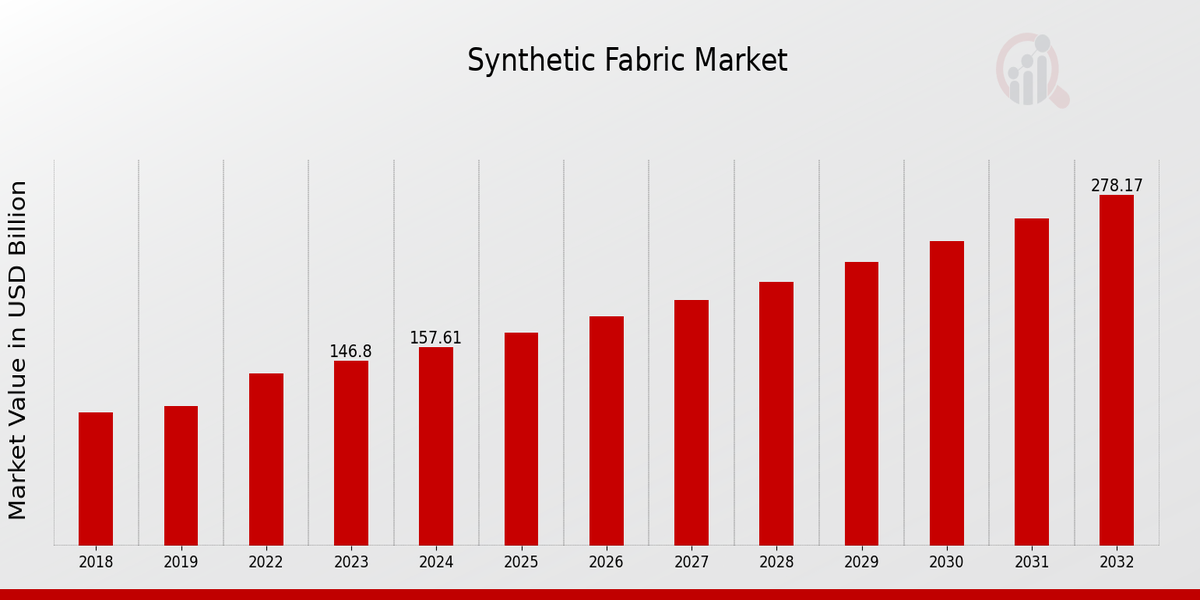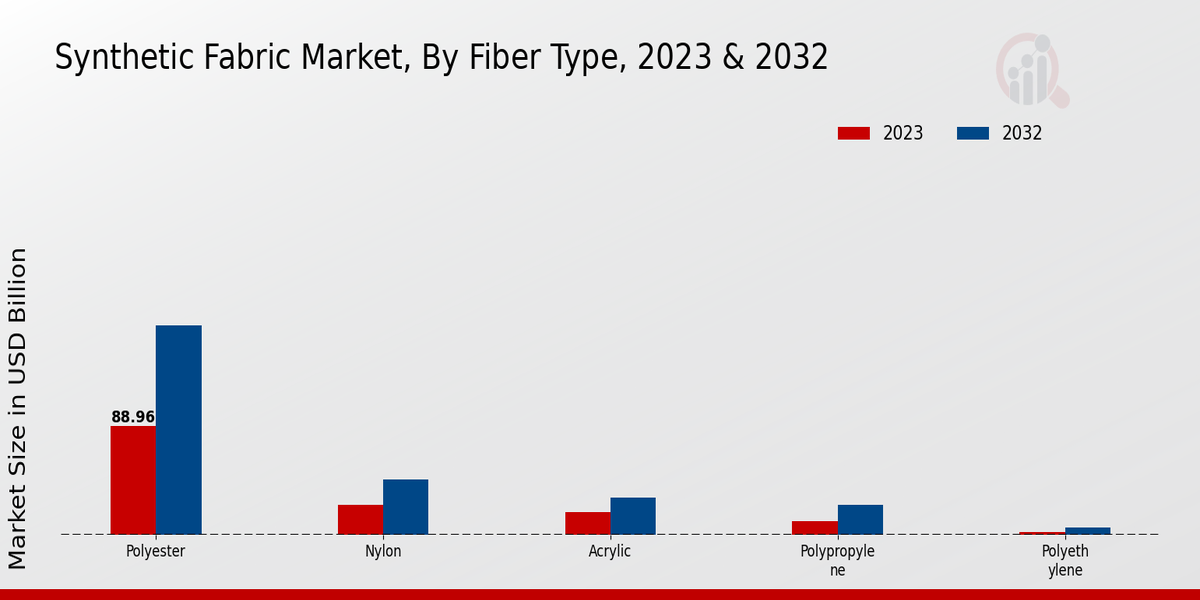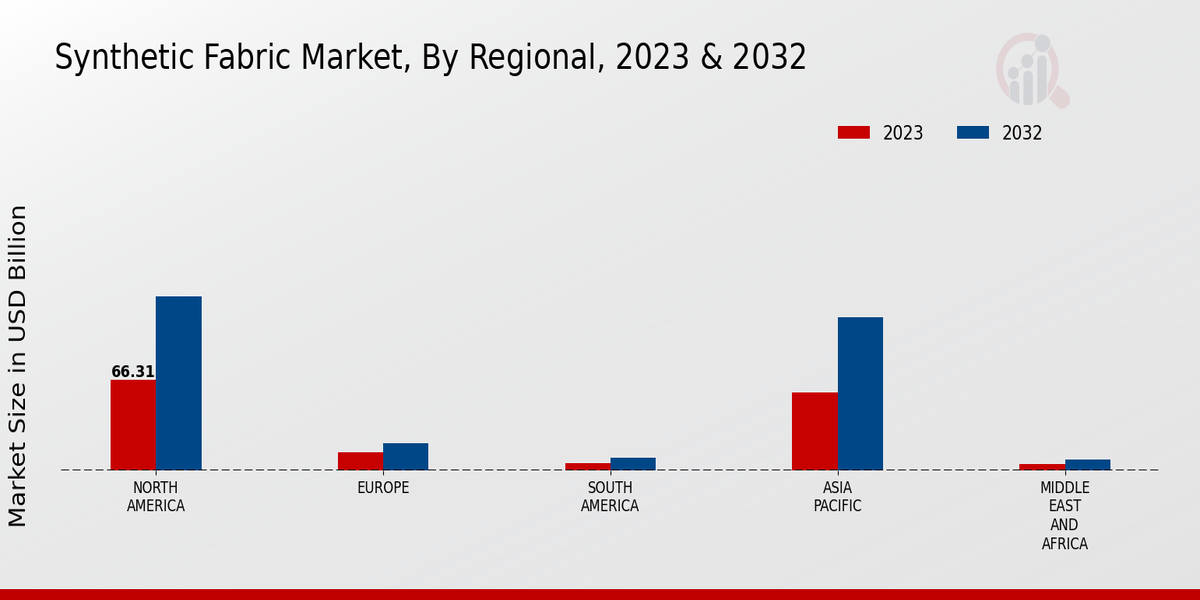Synthetic Fabric Market Overview
The Synthetic Fabric Market Size was estimated at 169.22 (USD Billion) in 2024. The Synthetic Fabric Market Industry is expected to grow from 181.68 (USD Billion) in 2025 to 344.31 (USD Billion) by 2034. The Synthetic Fabric Market CAGR (growth rate) is expected to be around 7.4% during the forecast period (2025 - 2034).
Key Synthetic Fabric Market Trends Highlighted
Key market drivers for the synthetic fabric market include rising demand for performance-oriented fabrics, growing disposable income, expanding urban population, and increasing awareness of eco-friendly textiles.
Opportunities in this market exist in venturing into emerging markets, cultivating eco-friendly bio-based synthetic fabrics, and other advanced technologies that may arise over time. Recent trends point towards recycled and bio-based synthetic fabrics, mass customization, and hybrids with improved performance characteristics. Major companies are focused on enhancing their R&D capabilities to adapt to these changing preferences of the consumers.
Among all these factors, underlying synthetic fabrics market is also expected to show stable levels of growth over the next few years due to innovations and increasing utilization of its application areas.

Source: Primary Research, Secondary Research, MRFR Database and Analyst Review
Synthetic Fabric Market Drivers
Increasing Demand for High-Performance Fabrics
One of the main drivers of the synthetic fabric market is a surge of demand for high-performance fabrics in numerous industries, such as automotive, aerospace, and healthcare. These fabrics have a range of excellent characteristics, such as high strength, durability, resistance to moisture and chemicals, and a lack of pores, rendering them suitable for specialized and demanding applications. The synthetic fabric market is experiencing growth as synthetic fabric is increasingly used in flight suits, lightweight and fuel-efficient vehicles, armor, protective clothing, tents, bagging and wrapping materials, and medical laser devices.
Rising Disposable Income and Population Growth
The rising disposable income and population growth in emerging economies are contributing to the increasing demand for synthetic fabrics. As consumers become more affluent, they are seeking higher-quality and more fashionable clothing and home textiles. The growing population also leads to an expanding consumer base for synthetic fabrics, particularly in countries with large youth populations.
Technological Advancements and Product Innovation
Recently, technological progress in the textile industry supplied the world with a wide range of new and innovative synthetic fabrics, each of them possessing a number of unique properties and features. Scientists and developers are now trying to combine the best properties of fabrics and broaden their application. The existing and new production technologies, such as melt-blown or electrospinning, will probably enable market growth.
Synthetic Fabric Market Segment Insights
Synthetic Fabric Market Fiber Type Insights
The synthetic fabric market is categorized by fiber types, including polyester, nylon, acrylic, polypropylene, and polyethylene. Polyester is the largest segment due to its inherent benefits in versatility, durability and cost-effectiveness. In 2023, polyester has reached 85.2 billion USD in terms of synthetic fabric market revenue. Meanwhile, another significant synthetic fiber – nylon, has been increasingly demanded in the automotive and sportswear industry. In 2023, the synthetic fabric market revenue for nylon was 23.6 billion USD, and it is expected to rise to 35.8 billion USD by 2032 while maintaining a CAGR of 7.45%.Acrylic is engineered to be soft, warm, and wrinkle-resistant. As a synthetic fiber, the synthetic fabric market revenue for acrylic is set to achieve a number of 18.4 billion USD by 2032, growing at a CAGR of 7.26%. Besides, polypropylene and polyethylene are also emerging in the synthetic fabric market because of their lightweight, water-repellent and chemical-resistant natures. The synthesis is estimated to obtain more than 24 billion USD in terms of market revenue by 2032. A driving force for the growth of the synthetic fabric market is the rising overall use of synthetic fibers in different industries, such as clothing, automotive, home decor and healthcare.Meanwhile, the market is also in demand for more environmentally friendly synthetic fibers and producing technology.

Source: Primary Research, Secondary Research, MRFR Database and Analyst Review
Synthetic Fabric Market End-Use Application Insights
The Synthetic Fabric Market is segmented by end-use application into Apparel, Home Furnishings, Automotive Interiors, Medical, and Industrial. The Apparel segment accounts for the largest share of the market, driven by the growing demand for synthetic fabrics in the fashion industry. The Home Furnishings segment is also expected to witness significant growth, owing to the increasing use of synthetic fabrics in furniture, curtains, and other home décor products. The Automotive Interiors segment is another major end-use application, with synthetic fabrics being used in car seats, headliners, and door panels.The Medical segment is also poised for growth, with synthetic fabrics being used in medical gowns, drapes, and other medical supplies. The Industrial segment is expected to witness steady growth, with synthetic fabrics being used in a variety of industrial applications, such as filtration, packaging, and construction.
Synthetic Fabric Market Production Method Insights
Synthetic Fabric Market has an offering for polyester or similar hollow filament production for use by telecom or optoelectronic industries by way of melt spinning, dry spinning or wet spinning synthetic fabrication method. Out of these three options, melt spinning has the major share of the market due to its very high complete effectiveness, versatility, and inexpensiveness. Melt Spinning is very popular in the production of various synthetic fibers incorporating nylon, polyester, and polypropylene synthetic fibers. This consists of the processes in which the polymer is liquefied, and fiber is generated with spinnerets. Another major production method is gaining traction, dry spinning, which occupies a sizable percent of the Synthetic Fabric Market revenue.
Such dry spinning is often applied for making cellulose acetate and acrylic fibers. In the course of this procedure, the poly solvent solution is forced into a warm gas atmosphere rapidly, evaporating the solvent and solid stretching the fibers. On the whole, cotton wet spinning cuts a lesser figure in the Synthetic Fabric Market and hence accounts for a smaller share of the increasing shares compared to melt spinning and dry spinning. Wet spinning is generally employed in making regenerated cellulose fibers such as rayon, viscose and others. It consists of the physical interference of the polymer solution directed into a cavitating fluid that, upon contact, causes the fibers to form due to chemical genesis.
The Synthetic Fabric Market Production Method Segmentation gives an analysis of the various technologies and processes used in the synthetic fabrics manufacturing process. This segmentation provides market players with an understanding of the various aspects and limits of each method encouraging them to improve their methods of production and the specific market needs satisfaction.
Synthetic Fabric Market Form Insights
The Synthetic Fabric Market is segmented by form into filaments, staples, and nonwovens. The filaments segment held the largest market share in 2023, accounting for over 40% of the market revenue. The staples segment is expected to grow at the highest CAGR during the forecast period, driven by increasing demand from the automotive and construction industries. Nonwovens are used in a wide range of applications, including hygiene products, wipes, and medical devices. The nonwovens segment is expected to grow at a steady pace during the forecast period, driven by increasing demand from the healthcare and hygiene industries.
Synthetic Fabric Market Sustainability Insights
The Sustainability segment is gaining traction in the Synthetic Fabric Market, driven by rising consumer awareness about environmental issues and the growing demand for eco-friendly products. Bio-based synthetic fabrics, made from renewable resources such as plant fibers and agricultural byproducts, are expected to witness significant growth, with a projected market revenue of USD 12.4 billion by 2024. Recyclable synthetic fabrics, which can be reprocessed and reused, are also gaining popularity, with an estimated market size of USD 10.6 billion in 2024.Biodegradable synthetic fabrics, which decompose naturally without harming the environment, represent a promising opportunity, with a projected market value of USD 8.9 billion by 2024. These eco-friendly fabrics offer sustainable alternatives to traditional synthetic materials, addressing environmental concerns and meeting the evolving demands of consumers.
Synthetic Fabric Market Regional Insights
The regional segmentation of the Synthetic Fabric Market offers valuable insights into the market's geographical distribution and growth dynamics. North America dominated the market in 2023, with a significant revenue share of over 35%. The region's developed economies, robust textile industry, and high demand for synthetic fabrics in various applications contribute to its leading position. Europe is another major market, accounting for approximately 25% of the revenue in 2023. The region's established fashion industry, technological advancements, and focus on sustainability drive market growth.The Asia-Pacific (APAC) region is expected to witness the highest growth rate during the forecast period, expanding at a CAGR of over 8%. The region's rapidly growing economies, expanding textile manufacturing base, and increasing disposable income are key factors driving market expansion. South America and the Middle East and Africa (MEA) regions are also poised for steady growth, supported by rising urbanization, population expansion, and growing demand for synthetic fabrics in various industries.

Source: Primary Research, Secondary Research, MRFR Database and Analyst Review
Synthetic Fabric Market Key Players and Competitive Insights
Major players in the Synthetic Fabric Market are investing heavily in research and development to create new and innovative products. They are also expanding their production capacities to meet the growing demand for synthetic fabrics. The Synthetic Fabric Market industry is expected to witness significant growth in the coming years, driven by increasing demand from various end-use industries such as automotive, apparel, and home furnishings. Leading Synthetic Fabric Market players are focusing on strategic partnerships and acquisitions to strengthen their market position. The Synthetic Fabric Market development is being driven by factors such as rising disposable income, increasing population, and growing urbanization.Invista, a leading company in the Synthetic Fabric Market, has a strong presence and offers a wide range of synthetic fabrics for various applications. The company has a strong focus on innovation and sustainability, and it is known for its high-quality products. INVISTA is also expanding its production capacities to meet the growing demand for synthetic fabrics.DuPont, a competitor company in the Synthetic Fabric Market, is another major player in the industry. The company has a long history of innovation and is known for its high-quality products. DuPont offers a wide range of synthetic fabrics for various applications, including apparel, automotive, and home furnishings. The company is also expanding its production capacities to meet the growing demand for synthetic fabrics.
Key Companies in the Synthetic Fabric Market Include
-
Lenzing AG
-
Reliance Industries Limited
-
Hyosung Corporation
-
Asahi Kasei Corporation
-
Mitsubishi Chemical Corporation
-
Kolon Industries, Inc.
-
Toray Industries, Inc.
-
Formosa Plastics Corporation
-
Invista, Inc.
-
Indorama Corporation
-
DuPont
-
Kuraray Co., Ltd.
-
The Dow Chemical Company
-
Teijin Limited
Synthetic Fabric Market Industry Developments
The Synthetic Fabric Market is projected to reach USD 278.2 billion by 2032, exhibiting a CAGR of 7.36% during the forecast period (2024-2032). Increasing demand from various end-use industries such as automotive, apparel, and home furnishings is driving market growth. Technological advancements in fiber production and the development of sustainable synthetic fabrics are further propelling market expansion. For instance, in January 2023, Toray Industries Inc. announced the development of a new type of synthetic leather made from plant-based materials, showcasing the industry's focus on sustainability. The market is also witnessing strategic partnerships and acquisitions, such as the recent collaboration between Hyosung and Patagonia to develop eco-friendly synthetic fabrics. These developments highlight the growing emphasis on innovation, sustainability, and collaboration in the Synthetic Fabric Market.
Synthetic Fabric Market Segmentation Insights
| Report Attribute/Metric |
Details |
| Market Size 2024 |
169.22 (USD Billion) |
| Market Size 2025 |
181.68 (USD Billion) |
| Market Size 2034 |
344.31 (USD Billion) |
| Compound Annual Growth Rate (CAGR) |
7.4% (2025 - 2034) |
| Report Coverage |
Revenue Forecast, Competitive Landscape, Growth Factors, and Trends |
| Base Year |
2024 |
| Market Forecast Period |
2025 - 2034 |
| Historical Data |
2020 - 2024 |
| Market Forecast Units |
USD Billion |
| Key Companies Profiled |
Lenzing AG, Reliance Industries Limited, Hyosung Corporation, Asahi Kasei Corporation, Mitsubishi Chemical Corporation, Kolon Industries, Inc., Toray Industries, Inc., Formosa Plastics Corporation, Invista, Inc., Indorama Corporation, DuPont, Kuraray Co., Ltd., The Dow Chemical Company, Teijin Limited |
| Segments Covered |
Fiber Type, End-Use Application, Production Method, Form, Sustainability, Regional |
| Key Market Opportunities |
Growing demand for technical textiles increasing use in sportswear and athleisure, rising popularity of sustainable fabrics, demand for lightweight and durable fabrics expanding applications in healthcare |
| Key Market Dynamics |
Rising demand for lightweight materials Surge in disposable income Technological advancements Growing awareness of sustainable practices Increasing demand from the automotive and construction industries |
| Countries Covered |
North America, Europe, APAC, South America, MEA |
Frequently Asked Questions (FAQ) :
The Synthetic Fabric Market reached a valuation of approximately USD 181.68 billion in 2025.
The Synthetic Fabric Market is projected to exhibit a CAGR of 7.4% from 2025 to 2034.
The Asia-Pacific region is anticipated to account for the largest market share in the Synthetic Fabric Market in 2023 due to the presence of a large textile and apparel industry.
Synthetic fabrics find extensive applications in various industries, including automotive, healthcare, sports apparel, home furnishings, and industrial products.
Some of the prominent players in the Synthetic Fabric Market include Toray Industries, Teijin Limited, Reliance Industries, SABIC, and INVISTA.
The increasing demand for lightweight, durable, and moisture-wicking fabrics, along with the rising adoption of synthetic fabrics in various industries, is propelling the growth of the Synthetic Fabric Market.
The Synthetic Fabric Market faces challenges related to environmental concerns associated with the production and disposal of synthetic fabrics, as well as competition from natural fibers.
The Synthetic Fabric Market is witnessing a growing adoption of sustainable and eco-friendly synthetic fabrics, as well as the development of innovative fabrics with enhanced functionalities.
The Synthetic Fabric Market is anticipated to continue its growth trajectory in the coming years, driven by the increasing demand from various industries and the ongoing advancements in synthetic fabric technology.
Unexplored applications in emerging markets, the development of specialty synthetic fabrics, and strategic partnerships and acquisitions present potential opportunities for growth in the Synthetic Fabric Market.

















